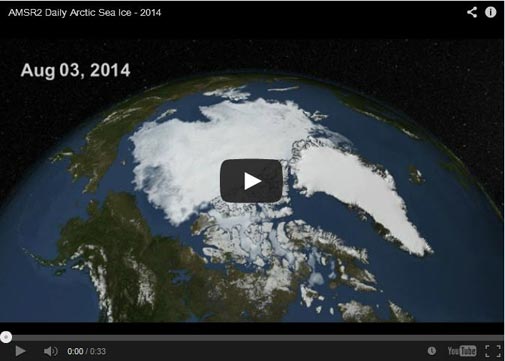NASA Scientists Watching, Studying Arctic Changes This Summer

This visualization of the Arctic sea ice cap’s seasonal melting is based on satellite data from the AMSR2 instrument operated by the Japan Aerospace Exploration Agency (JAXA). Image Credit: Cindy Starr, NASA Goddard's Scientific Visualization Studio
As of Aug. 19, Arctic sea ice covered about 2.31 million square miles. While this is on track to be larger than the record-breaking low year in 2012, the sea ice extent is still well below average for the past 30 years, and continues a trend of sea ice loss in the Arctic. From 1981 to 2010, the average sea ice extent on Aug. 19 was 2.72 million square miles – 18 percent larger than on that same date this year.
“While this year is not heading toward a record low minimum extent in the Arctic, sea ice is well below normal and continues an overall pattern of decreasing sea ice during summer in the Arctic,” said sea ice scientist Walt Meier, based at NASA’s Goddard Space Flight Center in Greenbelt, Maryland.
While NASA scientists have used satellites to document sea ice changes for more than 40 years, this summer the agency is also flying three airborne research campaigns to observe different aspects of climate-driven change in the Arctic.
The ARISE (Arctic Radiation-IceBridge Sea and Ice Experiment) campaign will begin flights later this week from Greenland to measure how changing land and sea ice conditions in the region are affecting the formation of clouds and the exchange of heat from Earth’s surface to space.
For some time scientists at NASA and elsewhere have been concerned about how the retreat of sea ice in summer could affect the climate of the Arctic. This campaign is one of the first to study the interaction between sea ice loss and the Arctic atmosphere.
The CARVE (Carbon in Arctic Reservoirs Vulnerability Experiment) campaign is making its third year of flights from Fairbanks, Alaska, over vast regions of Alaska to measure the emissions of greenhouse gases being released from thawing tundra and permafrost.
And an offshoot of NASA’s long-running Operation IceBridge, a plane will fly over Alaskan glaciers to measure how much the thickness of those glaciers has changed from previous years.
For news on these campaigns and the status of Arctic sea ice as it progresses toward its annual minimum, watch for updates on www.nasa.gov/earth and www.nasa.gov/earthrightnow throughout August and September.
Related links:
› ARISE: NASA to Investigate Climate Impacts of Arctic Sea Ice Loss
› CARVE: Is a Sleeping Climate Giant Stirring in the Arctic?
Patrick Lynch
NASA’s Earth Science News Team
Media Contact
All latest news from the category: Earth Sciences
Earth Sciences (also referred to as Geosciences), which deals with basic issues surrounding our planet, plays a vital role in the area of energy and raw materials supply.
Earth Sciences comprises subjects such as geology, geography, geological informatics, paleontology, mineralogy, petrography, crystallography, geophysics, geodesy, glaciology, cartography, photogrammetry, meteorology and seismology, early-warning systems, earthquake research and polar research.
Newest articles

Eruption of mega-magnetic star lights up nearby galaxy
Thanks to ESA satellites, an international team including UNIGE researchers has detected a giant eruption coming from a magnetar, an extremely magnetic neutron star. While ESA’s satellite INTEGRAL was observing…

Solving the riddle of the sphingolipids in coronary artery disease
Weill Cornell Medicine investigators have uncovered a way to unleash in blood vessels the protective effects of a type of fat-related molecule known as a sphingolipid, suggesting a promising new…

Rocks with the oldest evidence yet of Earth’s magnetic field
The 3.7 billion-year-old rocks may extend the magnetic field’s age by 200 million years. Geologists at MIT and Oxford University have uncovered ancient rocks in Greenland that bear the oldest…





















